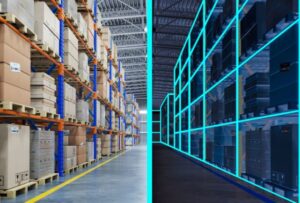In the fast-paced world of supply chain and logistics, warehouses play a critical role in ensuring the smooth flow of goods from manufacturers to consumers. However, warehouse operations are often plagued by inefficiencies, lack of visibility, and the constant challenge of managing a complex network of people, equipment, and inventory. This is where digital twins are making a significant impact.
What are Digital Twins?
Digital twins, in the context of warehousing, are virtual replicas of physical warehouses that leverage advanced analytics, machine learning, and real-time data to optimize operations, improve productivity, and reduce costs. They provide a comprehensive and accurate representation of the warehouse’s layout, inventory, equipment, and workflows. By creating a digital twin, warehouse operators can gain deep insights into their operations, simulate different scenarios, and make data-driven decisions to optimize performance.
Digital Twins in Warehouse Optimization
1. Layout Optimization
One of the key benefits of digital twins is their ability to help warehouse managers optimize the layout of their facilities. By simulating different layouts and configurations, managers can identify the most efficient placement of inventory, equipment, and machinery. This optimization leads to reduced picking and packing times, improved throughput, and minimized bottlenecks. Digital twins also enable managers to test the impact of layout changes before implementing them in the physical warehouse, saving time and resources.
2. Inventory Management
Digital twins provide warehouse managers with real-time visibility into their inventory. By creating a digital twin of the warehouse’s inventory, managers can track the location, quantity, and movement of products. This enables them to optimize inventory levels, reduce stockouts, and improve order fulfillment times. Through simulation and scenario modeling, managers can also test the impact of different inventory strategies and adjust their approach accordingly.
3. Equipment Monitoring
With digital twins, warehouse operators can monitor and analyze the performance of their equipment and machinery. By integrating sensors and other IoT devices with the digital twin, managers can track real-time data on equipment status and condition. This allows them to identify potential issues before they become problems, optimize maintenance schedules, and improve equipment utilization. Digital twins also enable predictive maintenance, where algorithms analyze data to predict when equipment is likely to fail and recommend proactive maintenance actions.
4. Process Optimization
Digital twins help warehouse managers optimize processes and workflows. By creating a digital twin of the warehouse’s processes, managers can identify bottlenecks, optimize resource allocation, and improve overall efficiency. Through simulation and scenario modeling, managers can test different process improvements and evaluate their impact before implementing them in the physical warehouse. This allows for continuous process improvement and increased operational efficiency.
5. Real-Time Analytics and Monitoring
Digital twins provide real-time analytics and monitoring of warehouse operations. By integrating sensors and IoT devices with the digital twin, managers can track key performance indicators, such as equipment utilization, inventory levels, and order fulfillment times. This real-time monitoring enables managers to quickly respond to changes in the warehouse environment, identify potential issues, and optimize operations in real-time. Machine learning algorithms can provide recommendations for optimizing operations based on real-time data, leading to improved productivity and efficiency.
The Future of Digital Twins in Warehouse Optimization
The adoption of digital twins in warehouse optimization is on the rise, and the technology is expected to play an increasingly significant role in the industry. As advancements in IoT, artificial intelligence, and machine learning continue, digital twins will become more sophisticated and capable of delivering even greater benefits. With real-time data, predictive analytics, and advanced simulation capabilities, digital twins will empower warehouse operators to make data-driven decisions, improve operational efficiency, and enhance overall supply chain performance.
Arvist: Transforming Warehouses with Real-Time Digital Twin Technology
One company at the forefront of digital twin technology in the warehousing industry is Arvist. Arvist’s AI and marker technology utilizes existing security camera feeds and relevant information to create real-time digital twins of warehouses and distribution centers. This innovative approach eliminates the need for additional infrastructure costs, such as IoT sensors or wearables while giving the advantages described above to the warehouse owners and operators.
Arvist’s digital twin technology provides actionable insights and operational improvements, enabling warehouse operators to unlock cost savings, drive up efficiencies, and elevate safety. By leveraging the power of real-time data and advanced analytics, Arvist empowers warehouse operators to make informed decisions, optimize processes, and improve overall warehouse performance. Get in touch with the team at Arvist to see how to start developing digital twin of your operations without any additional infrastructure investments
